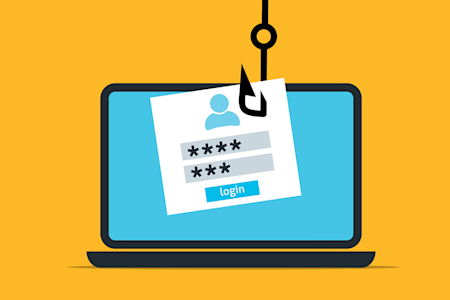Are you aware of the dangers of phishing attacks? According to a recent Verizon report, 82% of cyber breaches were human-involved through stolen credentials, phishing attacks, social engineering, impersonation, misuse, or error.
What Is a Phishing Attack?
Phishing is a cyber-attack where attackers impersonate legitimate entities to deceive individuals into divulging sensitive information. These attacks often come in the form of emails, text messages, or phone calls that appear to be from trusted sources, such as banks, companies, or colleagues. The primary goal of phishing is to trick recipients into revealing personal details like usernames, passwords, or credit card numbers.
Top Phishing Attack Techniques
Phishing attacks can vary widely in their approach, but some common techniques include:
Spear Phishing: Targeted attacks aimed at specific individuals or organizations, often using personalized information to appear more convincing.
Clone Phishing: A legitimate email with an attachment or link is copied and sent again, but with malicious modifications to the original content.
Whaling: High-profile phishing attacks targeting senior executives or important figures within a company, often involving highly customized and persuasive messages.
Smishing: Phishing attempts conducted via SMS, where attackers send text messages with links or requests for personal information.
Why Is Phishing a Major Concern for Individuals and Businesses?
Phishing is a major concern due to its potential to cause significant harm. For individuals, falling victim to phishing can lead to financial losses, identity theft, and personal data breaches. For businesses, phishing attacks can result in compromised sensitive information, financial loss, reputational damage, and operational disruptions.
10 Tips for Avoiding Phishing Attacks
1 - Educate yourself
Stay informed about the latest phishing tactics by attending security training sessions and reading about cybersecurity trends, news, incidents, and best practices. Because the sophistication and various types of phishing are constantly growing and evolving, staying informed on current threats is critical.
2 - Be vigilant and suspicious
Consciously question the legitimacy of each email, text message, and phone call. If you receive an unexpected email from a coworker, financial institution, government agency, or vendor, look out for these tell-tale signs of phishing:
Spelling or grammatical errors: Scammers intentionally include typos and grammatical mistakes in phishing emails to target unsuspecting and innocent victims while weeding out those too smart to fall for the scams. Typos in emails may bypass email security filters or create a sense of authenticity in the message. Additionally, these errors may occur when the sender is not proficient in the language used in the email.
Urgent demands for sensitive information: Emails using language with a sense of urgency or fear aims to make targets act quickly without thinking.
Suspicious links: Asking for personal information or downloading malware onto your device, phishing links may lead to suspicious websites.
Spoofed email addresses: Although phishing emails appear to be from a legitimate source, hovering over the sender’s email address can check if it matches the supposed organization.
Unexpected attachments: Malicious and harming your device or stealing your information, phishing emails may include unexpected attachments.
3 - Use strong passwords and two-factor authentication
Add an extra layer of security to your accounts by creating unique, strong passwords and enabling two-factor authentication wherever possible. Create strong passwords by combining uppercase and lowercase letters, numbers, and symbols.
Learn how strong your password is through Hive System’s infographic, and utilize Splashtop’s Vault to manage your passwords. Your accounts may be compromised without you knowing, so it is advised to regularly rotate passwords and add a second form of identification.
4 - Keep your software and security tools up to date
To protect against the latest threats, regularly update operating systems, anti-viruses, firewalls, and anti-malware software on all devices. These updates include security patches that address known vulnerabilities and protect you from phishing exploits.
5 - Never click on suspicious links or download attachments
Before clicking links or downloading attachments from unknown emails, text messages, or instant messages, think twice and hover your mouse over the link to examine the URL. Clicking a phishing link or attachment can lead to malware installation, data theft, or financial loss.
If you receive a suspicious message, check the email address for spelling errors or a generic greeting, and verify the legitimacy of messages with the sender.
6 - Be careful with personal information
Phishing attacks usually trick you into providing personal or financial information such as your username, password, or social security number. Be careful when sharing information online, as legitimate companies never ask via email or phone.
7 - Be wary of impersonating
Check for email address and sender name deviations. Common social engineering cues include:
Requests to obtain sensitive information
Asking for transfers of money
Unusual or sudden purchase requests
Sudden changes to direct deposit
8 - Stay cautious on public Wi-Fi
Avoid accessing sensitive information when using public Wi-Fi. Hackers may easily steal data from unsecured networks.
9 - Use anti-phishing tools
Download anti-phishing add-ons that can help protect you against phishing attacks on every device. These tools block access to malicious websites by analyzing emails and URLs for known phishing patterns. Here are some popular anti-phishing addons you can use:
Netcraft Extension: By monitoring websites and alerting them with a warning message when suspicious sites are detected, the anti-phishing add-on compares them against databases of phishing sites.
Avira Browser Safety: Blocking malicious websites such as phishing sites, the add-on scans downloads for malware.
Web of Trust (WOT): Basing their ratings on trustworthiness and reputation, the add-on warns users of websites' poor reputations.
10 - Always report suspicious activity
Immediately report suspected phishing scams to appropriate authorities, such as your IT department or the Federal Trade Commission. By reporting, you can help your IT department identify potential phishing threats so they can prevent further attacks in the future.
Why Are Remote Employees More Susceptible to Phishing Attacks?
Remote employees are particularly vulnerable to phishing attacks due to several key factors:
Limited Supervision: Remote workers often lack the direct oversight of in-office colleagues and IT teams, making it harder to spot and report suspicious activity promptly.
Use of Personal Devices: Personal devices and home networks typically have weaker security compared to corporate systems, increasing the risk of phishing.
Heavy Reliance on Digital Communication: Remote work depends on email, messaging apps, and video calls, which are common channels for phishing attempts. The high volume of digital communication can make it difficult to identify malicious messages.
Reduced Security Training: Remote employees may have less access to regular cybersecurity training, leaving them less prepared to recognize and handle phishing threats.
Increased Social Engineering Risks: Frequent interactions with external partners and clients provide more opportunities for social engineering attacks, where phishers pose as trusted contacts.
Addressing these vulnerabilities through targeted training and robust security measures is essential for protecting remote employees from phishing attacks.
Preventing Phishing Attacks Starts With You
Posing a significant threat to individuals and organizations, phishing attacks can lead to financial losses, reputation damage, and unauthorized access to private information.
However, employees can effectively mitigate these attacks by staying informed, being vigilant, and following these practical tips and techniques. Educating ourselves and others, staying cautious, and reporting suspicious activity can help prevent further phishing attacks and protect ourselves and our organizations from harm.
Get Started with Splashtop Secure Remote Access Solutions
Looking for a secure remote access solution for your business? Splashtop remote access software provides a secure way for employees to access their work computers from anywhere, with features includind end-to-end encryption, MFA, role-based access controls, logging, and more. With Splashtop, you can have peace of mind knowing that your data and network are safe. Learn more about Splashtop security and all Splashtop solutions.
To test your phishing knowledge, take Google’s free online phishing quiz!





